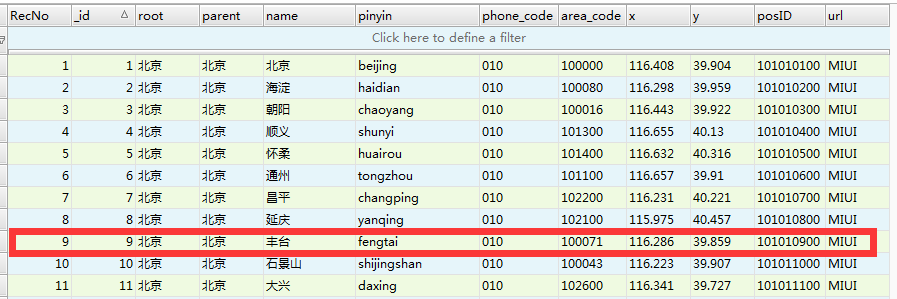这篇文章主要为大家展示了“Android开发如何读取assets目录下db文件”,内容简而易懂,条理清晰,希望能够帮助大家解决疑惑,下面让小编带领大家一起研究并学习一下“Android开发如何读取assets目录下db文件”这篇文章吧。
具体如下:
最近准备打算写一个关于天气预报的app,偶然的机会在一大神的博客上看到了一个获取天气的api,获取天气是通过城市的cityID,项目中准备通过读取weather_city.db数据库来查询cityID,这篇文章写怎么读取assets目录下的db文件,其实方法也挺简单的就是把assets目录下的db文件复制一份到”/data/data/” + packName + “/”目录下而已。
public class DBManager {
private String DB_NAME = "weather_city.db";
private Context mContext;
public DBManager(Context mContext) {
this.mContext = mContext;
}
//把assets目录下的db文件复制到dbpath下
public SQLiteDatabase DBManager(String packName) {
String dbPath = "/data/data/" + packName
+ "/databases/" + DB_NAME;
if (!new File(dbPath).exists()) {
try {
FileOutputStream out = new FileOutputStream(dbPath);
InputStream in = mContext.getAssets().open("weather_city.db");
byte[] buffer = new byte[1024];
int readBytes = 0;
while ((readBytes = in.read(buffer)) != -1)
out.write(buffer, 0, readBytes);
in.close();
out.close();
} catch (IOException e) {
e.printStackTrace();
}
}
return SQLiteDatabase.openOrCreateDatabase(dbPath, null);
}
//查询
public City query(SQLiteDatabase sqliteDB, String[] columns, String selection, String[] selectionArgs) {
City city = null;
try {
String table = "city";
Cursor cursor = sqliteDB.query(table, columns, selection, selectionArgs, null, null, null);
if (cursor.moveToFirst()) {
String parentCity = cursor.getString(cursor
.getColumnIndex("parent"));
String phoneCode = cursor.getString(cursor.getColumnIndex("phone_code"));
String name = cursor.getString(cursor.getColumnIndex("name"));
String pinyin = cursor.getString(cursor.getColumnIndex("pinyin"));
String cityID = cursor.getString(cursor.getColumnIndex("posID"));
String areaCode = cursor.getString(cursor.getColumnIndex("area_code"));
city = new City(parentCity, name, pinyin, phoneCode, cityID, areaCode);
cursor.moveToNext();
cursor.close();
}
} catch (Exception e) {
e.printStackTrace();
}
return city;
}
}为了方便数据的使用,我们建一个City类,对应City表中的字段,如下:
public class City {
private String parentCity;
private String childCity;
private String pinyin;
private String phoneCode;
private String cityID;
private String areaCode;
public City(String parentCity, String childCity, String pinyin, String phoneCode, String cityID, String areaCode) {
this.parentCity = parentCity;
this.childCity = childCity;
this.pinyin = pinyin;
this.phoneCode = phoneCode;
this.cityID = cityID;
this.areaCode = areaCode;
}
public String getParentCity() {
return parentCity;
}
public void setParentCity(String parentCity) {
this.parentCity = parentCity;
}
public String getAreaCode() {
return areaCode;
}
public void setAreaCode(String areaCode) {
this.areaCode = areaCode;
}
public String getCityID() {
return cityID;
}
public void setCityID(String cityID) {
this.cityID = cityID;
}
public String getPhoneCode() {
return phoneCode;
}
public void setPhoneCode(String phoneCode) {
this.phoneCode = phoneCode;
}
public String getPinyin() {
return pinyin;
}
public void setPinyin(String pinyin) {
this.pinyin = pinyin;
}
public String getChildCity() {
return childCity;
}
public void setChildCity(String childCity) {
this.childCity = childCity;
}
}测试代码:
@Override
protected void onCreate(Bundle savedInstanceState) {
super.onCreate(savedInstanceState);
setContentView(R.layout.activity_main);
contentTextView = (TextView) findViewById(R.id.content);
dbManager = new DBManager(this);
sqLiteDatabase = dbManager.initDBManager(getPackageName());
String[] columns = new String[]{"parent", "name", "posID", "pinyin", "phone_code", "area_code"};
String selection = "parent=?" + "AND" + " name=?";
String[] selectionArgs = new String[]{"北京", "丰台"};
City city = dbManager.query(sqLiteDatabase, columns, selection, selectionArgs);
contentTextView.setText("邮编:" + city.getAreaCode() + "拼音:" + city.getPinyin() + "电话区号" + city.getPhoneCode() + "cityID:" + city.getCityID());
}
读取的数据与表中的数据一致

以上是“Android开发如何读取assets目录下db文件”这篇文章的所有内容,感谢各位的阅读!相信大家都有了一定的了解,希望分享的内容对大家有所帮助,如果还想学习更多知识,欢迎关注亿速云行业资讯频道!
免责声明:本站发布的内容(图片、视频和文字)以原创、转载和分享为主,文章观点不代表本网站立场,如果涉及侵权请联系站长邮箱:is@yisu.com进行举报,并提供相关证据,一经查实,将立刻删除涉嫌侵权内容。